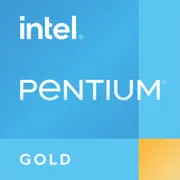Intel Pentium Gold 4415Y

インテル ペンティウム ゴールド 4415Y: 基本的なタスクのためのコンパクトなエネルギー効率
2025年4月
イントロダクション
2017年に発売されたインテル ペンティウム ゴールド 4415Yは、現在でも予算型ノートパソコンやウルトラポータブルデバイスで見かけます。古いアーキテクチャにもかかわらず、特定の使用シcenarioにおいては依然として有用です。本記事では、2025年にこのCPUがどのようなユーザーに適しているか、また考慮すべき妥協点について考察します。
アーキテクチャとプロセス:控えめな性能
コア、スレッド、クロック周波数
ペンティウム ゴールド 4415Yは、Kaby Lakeアーキテクチャ(14nm)に基づいており、低消費電力のスーパーエコノミープロセッサに分類されます。主なスペックは以下の通り:
- 2コア、4スレッド(ハイパースレッディングのおかげ)。
- ベース周波数:1.6 GHz。ターボモードはなく、負荷がかかっても一定の周波数を維持します。
- キャッシュ:2MB L3。
統合グラフィックス
内蔵GPUはインテル HD グラフィックス 615で、24の実行ユニット(EU)と最大850MHzの周波数を持ちます。これは4K(ハードウェアデコーディング対応)でのビデオ処理が可能な控えめなグラフィックスアクセラレーターですが、最新のゲームには適していません。
消費電力とTDP:自律性を優先
このプロセッサのTDPは6Wであり、アクティブ冷却なしでのデバイス(例:タブレットや超薄型ノートパソコン)の使用を可能にします。これは以下のような形式において重要な利点となります:
- 静かな動作。
- 最小限の薄さ。
- 長いバッテリー持続時間。
しかし、低いTDPは性能を制限します — CPUは熱設計パワーに余裕がないため、高いクロック周波数を長時間維持することができません。
性能:現実的な期待
オフィスタスクとマルチメディア
- オフィスアプリケーション(Word、Excel、5〜10タブのブラウザー):プロセッサは処理できますが、複数のプログラムを同時に実行すると遅延が発生します。
- ビデオ再生:YouTubeやローカルファイルでの4K/60 FPS再生(VP9およびHEVCデコーダーのおかげ)。
- 画像編集ソフト:LightroomやPhotoshopでの基本的なレタッチは可能ですが、レンダリングにはより長い時間がかかります。
ゲーム
HD グラフィックス 615は、カジュアルなプロジェクトに適したグラフィックスです:
- Minecraft(低設定で30〜40 FPS)。
- CS:GO(720p、低詳細、〜25〜30 FPS)。
- 現代のAAAゲーム(たとえば、Cyberpunk 2077)は起動できません。
ターボモード:動的オーバークロックの未実装
ターボブーストがないことが最大の欠点です。負荷時でも周波数は1.6GHzのままで、リソース集約タスクにおける性能を制限します。
使用シナリオ:4415Yは誰のためにあるのか
1. 学生 — テキスト作成、プレゼンテーション、オンラインコースに最適。
2. オフィスワーカー — メール、ドキュメント、ビデオ会議。
3. ポータブルデバイスユーザー — 薄型ノートパソコン(たとえば、同等のCPUを搭載したMicrosoft Surface Go)。
4. バックアップデバイス — 旅行用のセカンドノートパソコンとして。
不向きなケース:
- ビデオ編集。
- 3Dモデリング。
- 最新のゲーム。
自律性:理想的な条件下で10時間まで
TDP 6Wのおかげで、ペンティウム ゴールド 4415Yを搭載したノートパソコンは、適度な負荷(画面の明るさ50%、Wi-Fi使用、オフィスタスク)で8〜10時間のバッテリー動作時間を示します。これに寄与する要因は:
- SpeedStepテクノロジー — アイドル時に動的に周波数を下げる。
- Windows/Linuxでの省エネルギーモード。
ただし、自律性はバッテリーの容量に大きく依存します。例えば:
- 38W·hのバッテリーを搭載したノートパソコン(ASUS VivoBook) — 7時間まで。
- 50W·hのバッテリーを持つデバイス(Lenovo IdeaPad) — 10時間まで。
競合との比較:予算セグメントの争い
AMD アスロン シルバー 3050e (2020)
- 2コア/2スレッド、Vega 3 GPU。
- TDP 6Wながら、グラフィックスは15〜20%強力。
- ゲームでは優れていますが、マルチスレッドタスクでは劣ります。
Apple M1 (2020)
直の競合ではありませんが、2025年には中古のM1搭載MacBook Air($400〜500)がすべての面でペンティウムゴールドを上回ります。自律性を含めて。
インテル セレロン N4500 (2021)
- 2コア/2スレッド、TDP 6W。
- ハイパースレッディングがないため、マルチスレッド性能は劣ります。
結論:ペンティウム ゴールド 4415Yは2025年には$350以下のデバイスでのみ有効です。$400以上の予算がある場合は、インテル アルダーレイク-N(例えばN100)やAMD Ryzen 3 7320Uを搭載したノートパソコンを選ぶ方が理にかなっています。
長所と短所
強み
- 低消費電力と無音性。
- 4Kビデオのサポート。
- 手頃な価格のデバイス($300〜450)。
欠点
- マルチタスク時の性能が低い。
- 古い14nmプロセス。
- ターボブーストがない。
ノートパソコン選びの推奨
1. デバイスタイプ:ウルトラブックまたはトランスフォーマー(例:HP Pavilion x360)。
2. 最低スペック:
- 8GB RAM(2025年には4GBは苦痛)。
- 256GB SSD(HDDではない!)。
- 解像度1920×1080のIPS画面。
3. 最適モデル:
- Lenovo IdeaPad 3 15IGL05($330) — 15.6インチ、8/256GB。
- ASUS Laptop 14 F415MA($299) — 14インチ、4/128GB(アップグレードが必要)。
避けるべき:
- 1366×768の画面を持つノートパソコン。
- 4GB RAMの構成。
最終的な結論:ペンティウム ゴールド 4415Yが適している人
このプロセッサは以下の条件を持つ人に最適です:
1. 基本的なタスク用の安価なノートパソコンを探している。
2. 自律性とポータビリティを重視する。
3. 要求の厳しいアプリケーションを起動する予定がない。
主な利点:
- デバイスの低価格。
- 一日中充電なしで作業できる。
- ウェブサーフィンやオフィス作業に十分な性能。
2025年の代替案:$100〜150追加可能であれば、インテル N100やAMD Ryzen 3 7320Uを搭載したノートパソコンを検討してください。これらはより優れた性能と最新のテクノロジー(Wi-Fi 6、USB-Cのパワーデリバリー)を提供します。
基本
CPUの仕様
メモリ仕様
GPUの仕様
その他
ソーシャルメディアで共有する
または当サイトへのリンクを追加
<a href="https://cputronic.com/ja/cpu/intel-pentium-gold-4415y" target="_blank">Intel Pentium Gold 4415Y</a>